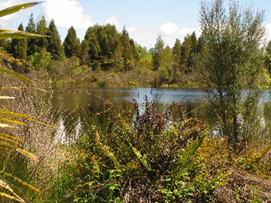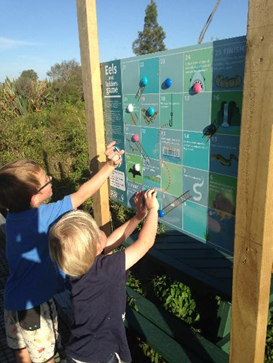Lake Rotopiko (Serpentine Lakes)
Rotopiko is a complex of three small peat lakes near Ohaupo in the Waipa District. Originally a single lake that formed at the end of the last ice-age, drainage of the surrounding land over the past century lowered the water level, creating three lakes connected by areas of swamp. East Lake (the smallest of the three) has one of the best representations of natural aquatic plant assemblages in the Waikato region. Its relative lack of invasive aquatic plants is extremely unusual - both at regional and national levels, making the Rotopiko complex nationally significant. The lakes and their immediate margins are managed by the Department of Conservation as a 30 hectare Wildlife Management Reserve, while a further 10 hectares of land is Waipa District Council reserve land.
Restoring Rotopiko
 In 2011, following a blessing by local hapū, Ngāti Apakura, the National Wetland Trust began a significant community-led restoration project. Restoring the site is an important first step towards the Trust’s plans to build a National Wetland Discovery Centre at Rotopiko.
In 2011, following a blessing by local hapū, Ngāti Apakura, the National Wetland Trust began a significant community-led restoration project. Restoring the site is an important first step towards the Trust’s plans to build a National Wetland Discovery Centre at Rotopiko.
What has been done
The National Wetland Trust and its partners (including Waikato Regional Council, Waipa District Council, Department of Conservation and New Zealand Landcare Trust) have:
- constructed a 1.4 kilometre predator fence around East Lake and eradicated mammalian pests
- formed a care group that carries out regular intensive animal pest control around the 30 hectares of reserve land outside the pest fence
- restored or replanted seven hectares of vegetation, and reinstated a rare peatland community
- installed sediment traps on the main inlet drains
- developed new ponds and scrapes for wading birds and waterfowl
- created over 3 kilometres of formed walkways and viewing platforms and installed an interactive hands-on discovery trail for families and school groups.
Wildlife and plant life
Wildlife surveys, carried out with the help of Te Awamutu Intermediate and Te Awamutu Scouts and Keas, have confirmed the presence and return of many native species, including pūweto (spotless crake), mātātā (fernbird), kārearea (falcon), pekapeka (long-tailed bats), and a dramatic increase in the number of vulnerable species including wētā and copper skinks.
The lake is inhabited by tuna (longfin and shortfin eels) and common bullies, while the drains are important habitat for waikaka, the threatened black mudfish.
Inside the pest fence a centuries-old kahikatea forest adds to the diversity of the site. Walkways through the forest offer close-up views of the towering trees and their massive trunks.
Since about 2000, there has been a programme to control pest fish such as rudd, catfish and goldfish from the lakes to protect the special native plants found in the lakes.
Educational opportunities
 The National Wetland Trust has developed a curriculum-linked education kit to complement its interactive discovery trail. Visiting school groups can learn about a wide range of wetland and ecosystem management themes, including water quality, wetland birds, tuna (long-finned eels), moko (native lizards), kahikatea forest, and pest management. The students work book and teacher guides are available from the National Wetland Trust.
The National Wetland Trust has developed a curriculum-linked education kit to complement its interactive discovery trail. Visiting school groups can learn about a wide range of wetland and ecosystem management themes, including water quality, wetland birds, tuna (long-finned eels), moko (native lizards), kahikatea forest, and pest management. The students work book and teacher guides are available from the National Wetland Trust.
Families can also learn about wetlands from the discovery trail, which comprises stories and fun activities such as mudfish scrabble and eels and ladders.
